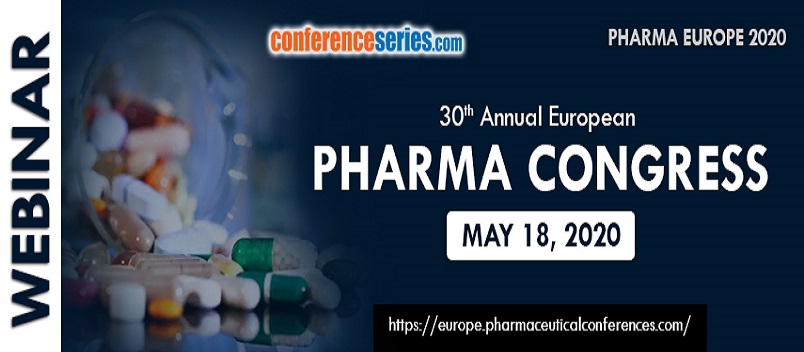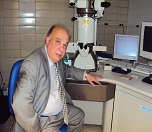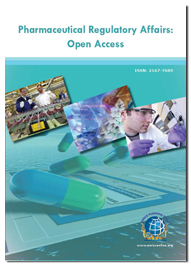Theme:
Pharma Europe 2020
The most anticipated Pharma event in the world and you're invited to attend 30th Annual European Pharma Congress scheduled during May 18-19,2020 which includes prompt keynote presentations, Oral talks, Poster presentations and Exhibitions! This strategic conference will provide in-depth presentations and interactive sessions, for the possibility to network with like-minded professionals and discuss how to overcome the current challenges in pharmaceutical product synthesis and product development. The focus this year will be on the latest advancements, research and development to inspect the challenges in Pharmaceutical Sciences, Clinical Research and related areas. Pharma Europe 2020 is a specially designed cluster of all European Pharma conferences. The main theme of this Pharma conference is “ Emerging trends in development of vaccines for Covid 19 ” which covers a wide range of critically important sessions.
At Pharma Europe 2020 meet your target audiences from around the world focused on learning about Pharma and Pharma regulations, licenses, approvals. This conference would be your single best opportunity to reach the largest assemblage of participants from the Pharma field.
2020 Highlights:
- 300+ Participation (70 Industry: 30 Academia)
- 10+ Keynote Speakers
- 50+ Plenary Speakers
- 20+ Exhibitors
- 14 Innovative Educational Sessions
- 5+ Workshops
- B2B Meetings
Motives to attend:
-
This year, we will have more senior speakers, who will be joining us from pharmaceutical giants. They're coming to share their experience with us and ensure you can maximize your knowledge.
They also want to join us because they know how important it is to have your questions answered. In light of all that's happening in the Pharmaceutical industry, this year delivers more case studies for you to gain first-hand experience on developing your drugs, clinical trials, and we will be introducing think tank sessions to discuss and debate challenges in more detail with key decision makers. These sessions will bring you constructive networking possibilities so you return to work with practical solutions for your challenges.
- Get ahead of the competition: Gather fresh intuitions from key speakers to help make restored decisions on doing business in Pharma
- Meet & Connect with Senior Stakeholders from the global Pharma network
- Content your way: Access a variety of technical and commercial tracks across the entire supply chain, or choose the one track that is most relevant to your business
- Save months of research: Don’t spend eras reading whitepapers, come and hear from the decision makers themselves on the latest trends, challenges and opportunities at the forefront of the industry
- A Unique Opportunity for Advertisers and Sponsors at this International event
- Triumph of Awards, Certificates recognizes your commitment to your profession to encourage the nascent research.
Over 50+ organizations and international pavilions will be exhibiting at the Pharma Europe 2019 conference. Exhibitors will include equipment manufacturers and suppliers, systems providers, finance and investment firms, R&D companies, project developers, trade associations, and government agencies.
In addition to the products and services you will have access to valuable content, including Keynote Presentations, Product Demonstrations and Educational Sessions from today’s industry leaders.
Target Audience:
- Directors, CEO’s of Organizations
- Business Development Managers
- Chief Scientific Officers
- R&D Researchers from Pharma Industries
- Professors, Associate Professors, Assistant Professors
- PhD Scholars
- Patent Attorneys
- Investment Analysts
- Association, Association presidents and professionals
- Noble laureates in Health Care and Medicine
- Bio instruments Professionals
- Bio-informatics Professionals
- Software development companies
- Research Institutes and members
- Supply Chain companies
- Manufacturing Companies
- CRO and DATA management Companies
- Training Institutes
- Business Entrepreneurs
Young Scientist Benefits
- Our conferences provide best Platform for your research through oral presentations.
- Share the ideas with both eminent researchers and mentors.
- Young Scientist Award reorganization certificate and memento to the winners
- Young Scientists will get appropriate and timely information by this Forum.
- Platform for collaboration among young researchers for better development
- Award should motivate participants to strive to realize their full potential which could in turn be beneficial to the field as whole.
Deadline for Registrations:
- Platform for collaboration among young researchers for better development
- Till December 30, 2019 – $399
- Till January 30, 2020 – $499
- Till February 28, 2020 – $599
The Growing Pharmaceuticals Market: Expert Forecasts and Analysis
The global pharmaceuticals market was worth $934.8 billion in 2017 and will reach $1170 billion in 2021, growing at 5.8%, according to a recent pharma market research report by The Business Research Company.
This is an accelerated pace compared to 5.2% for the years before 2017, but is slower than the other two large healthcare segments, medical equipment and healthcare services. Healthcare as a whole is growing at over 7% year on year.
The factors that affect the pharmaceutical market size include disease prevalence, drug affordability, consumer attitudes, government policies and some supply-side factors:
- Disease prevalence is related to population size, age, genetic inheritance and behaviour (infectious disease incidence is lower where sanitation practices are better; sedentary lifestyles also encourage chronic disease).
- Affordability is related to income but also to drug prices.
- Consumer attitudes include willingness to use alternative therapies or distrust of taking drugs.
- Government (and insurance company) policies affect reimbursement and who the payer is. Other government policies determine regulation, which can be a significant barrier to the launch of new treatments.
- A major supply-side factor is availability of an appropriate treatment, which may be a matter of quantity, as in an epidemic, or of drug discovery and development.
PESTEL Analysis for the Pharmaceuticals Market
Current and ongoing changes in political, economic, social, technological, legal and environmental factors are influencing growth in the healthcare market, where drugs play an important part. The following factors are all boosting healthcare market growth:
- Reduced taxes and lowered drug prices in the USA
- GDP growth of over 6% in China and India
- Widespread population aging and sedentary lifestyles leading to increased chronic disease prevalence
- Industrialized data services in R&D enabling the use of clinical trial data in trial simulations
- Lowered regulatory barriers for new drugs in the USA
- High urban pollution levels increasing the incidence of conditions like asthma
As a result, healthcare expenditure per capita is set to rise from its 2017 level of $1137 to $1427 by 2021.
Pharmaceutical Market Restraints and Drivers
Part of the explanation for the relatively slow current growth of the pharma market is that the launch of major new products has slowed and that companies are restricting their R&D investment. For example, despite the huge potential for any effective and safe new drug for treating Alzheimer’s disease, Pfizer has ended its Alzheimer’s research program while AstraZeneca and GSK have cut back. High failure rates, the $2 billion average cost of developing a new drug, and falling returns on investment — down from 10.1% a year in 2010 to 3.2% in 2017 for the big pharma companies, according to Deloitte’s — are restraining the launch of high-priced new breakthrough drugs such as those that boosted the market in earlier years.
Most pharmaceutical industry growth now is coming instead from the increased size of the global aging population, which boosts demand for long-term treatments for chronic diseases, and better access to healthcare in emerging economies.
The Changing Geography of Pharma Markets
Growth over past decades means that North America and Western Europe still account for 56% of the global market, but Asia Pacific has overtaken Western Europe as the second largest region. Growth in Asia Pacific is fueled by increased affordability of drugs resulting from the launch of low-priced generics. Other factors that are positive for growth in Asia Pacific are the rise of GDP per capita in the region, government programs to support healthcare, and rapid urbanization, which brings both doctors and pharmacies within easy reach of increasing proportions of growing populations. Pharma sales in Asia Pacific will grow at 8.4% a year to 2021.
The story is a similar one at the level of country. The USA, by itself worth 25% of the global total, is restraining global growth by rising at below 5% a year, while the much smaller pharma markets of India and China are both achieving double that pace.
Key Segments in the Pharmaceutical Market
The largest pharma market globally is for musculoskeletal drugs. These are treatments for diseases such as rheumatoid- and osteo- arthritis, osteoporosis, carpal tunnel syndrome, tendonitis, rotator cuff tear, muscular dystrophy, myasthenia gravis, lupus erythematosus and others. Major drugs in this segment include Piroxicam Glaxo, Dolonex, Felden, and Piroxicam Pfizer. The segment accounted for 14% of the global total in 2017. Cardiovascular, oncology and ant-infective drugs are the second third and fourth largest markets.
Drugs for treating metabolic disorders such as diabetes and diseases of the thyroid and pituitary glands will be the fastest-growing segment of the global pharma market to 2021. This segment will grow at 9% a year going forward, following recent growth of 11.6%, but it will remain in fifth place for market size.
Anti-diabetic drugs are the largest subsegment of the global pharmaceutical industry, worth over $85 billion in 2017; second are the anti-virals and third come anti-hypertensives. Drugs for some of the less prevalent cancers — thyroid, skin and ovarian cancer — are the fastest-growing subsegments. This is in part because the US Federal Drug Administration has allowed a less rigorous regulatory procedure and lower endpoint benchmark for cancer drugs, so increasing the rate of innovation.
Competitive Landscape & Top Pharmaceutical Companies
Pharmaceutical drugs are subject to a large number of laws and regulations that deal with patenting, testing, safety, efficacy and marketing and affect the size and growth rates of the market. Together with the high R&D costs involved in creating new drug solutions, these can act as barriers to entry for small companies. However, pharmaceutical companies produce both generic and branded drugs. Generics, which are copies of patent-expired drugs, are opportunities for smaller entrants. They are taking an increasing share of the market, particularly in developing economies, where governments are encouraging their production in order to make lower-price treatments more widely available.
In the overall market, top pharmaceutical companies include:
- Novartis
- Sanofi
- Pfizer
- Hoffman-La Roche
- Gilead
Together the top ten pharmaceutical companies account for 30% of global sales, making the market moderately fragmented. Within individual segments, however, the share of these pharmaceutical companies varies: Hoffman-La Roche is by some way the leading pharmaceutical company in the large oncology drugs market, but Sanofi leads in the cardiovascular and metabolic disorders segments.
In markets where biologics have penetrated, the leading players are not in the top ten pharma manufacturers: Biogen, for instance, leads in the central nervous system segment, while Bristol-Myers Squibb and Eli Lilley have significant shares in oncology.
Deal activity in the healthcare industry has surged in recent years. Most mergers and acquisitions are aimed at boosting product portfolios and expanding the market reach of products and services. For example, in August 2014 Merck acquired a clinical-stage pharmaceutical company, Idenix Pharmaceuticals Inc., for nearly $4 billion. Through this acquisition Merck strengthened its product portfolio by adding Idenix’s potential hepatitis drugs.
Data Segmentations: Pharmaceutical drugs global market, global pharmaceutical drugs market by therapeutic area segments and subsegments; pharmaceutical drugs market by region and country and by therapeutic area segments; branded versus generic drugs markets by country; competitor drug sales and market shares by therapeutic area; global healthcare market historic and forecast size and growth; healthcare market regional and country size and growth; healthcare market competitive landscape.
A look ahead into 2019 Global Market Analysis :
One of the key items to look for in 2019 is how the pharmaceutical industry will fare with new product approvals. In 2018, the US Food and Drug Administration’s (FDA) Center for Drug Evaluation and Research (CDER) approved a record-high 59 new molecular entities (NMEs), surpassing the previous record of 53 NME approvals in 1996 and the 46 NMEs approved in 2017. The 59 NME approvals in 2018 was nearly double the 10-year (2009–2017) average of 33 NME approvals by FDA’s CDER. The record-number of NME approvals continues an upward trajectory for NME approvals (with the exception of 2016 when 22 NMEs were approved) over the last several years. FDA’s CDER approved 41 NMEs in 2014, 45 NMEs in 2015, 46 NMEs in 2017, and the 59 NMEs thus far in 2018.
In addition, continuing a recent trend, orphan drugs accounted for a large percentage of NME approvals. More than half (58%), or 34, of the NME approvals in 2018 were for orphan drugs, defined as drugs that treat 200,000 or fewer people in the US. In 2017, 39%, or 18 of the 46 NMEs approved by the FDA’s CDER were orphan drugs, which continued a recent trend of approximately 40% of NME approvals being orphan drugs. In 2016, 9 of the 22 NMEs approved by the FDA were orphan drugs. Of these 22 NME approvals, two were diagnostic agents, so 9, or 45%, of the new drugs approved in 2016 were orphan drugs. In 2015, 47%, or 21 of the 45 NMEs approved by the FDA’s CDER were orphan drugs, and in 2014, 41%, or 17 of the 41 NMEs approved were orphan drugs.
The key question for the pharmaceutical industry in 2019 is whether the innovation train will continue to roll.
Despite the optimism for product innovation based on NME approvals in 2018, other issues may have a dampening effect, notably financing into the biopharmaceutical industry. “Biopharma has had a rocky few months, and many expect life to get tougher as we head into 2019,” said Amy Brown, author of a recent report by Vantage, the editorial arm of Evaluate Ltd, in highlighting key predictions for the pharmaceutical industry in 2019. “The sector will need to deliver on its innovation promises next year if it wants to rise above wider economic and financial concerns.”
In the US, a total of $4.0 billion was invested into biotechnology-related industries in the third quarter of 2018 (the latest available data as of press time), which represented a 1% decrease from the second quarter of 2018 while deals remained constant quarter on quarter with 120 deals each in the third and second quarters of 2018, according to the Healthcare MoneyTree report by PwC and CB Insights. The biotechnology subsector raised $2.160 billion in the third quarter of 2018, a 7% increase from the second quarter of 2018. Out of the 59 deals, closed in the third quarter, six were mega-round deals, which contributed $1.176 billion of the dollars invested in the third quarter. The drug-development subsector raised $884 million in the third quarter of 2018, a 31% decrease from the second-quarter of 2018. Out of the 31 deals closed, none were mega-round deals. For the other subsectors in biotechnology-related industries, the medial device & equipment industry raised $750 million in 45 deals in the third quarter of 2018, a decrease of 4% from the second quarter of 2018, in terms of dollars invested, according to the PwC/CB Insights’ Healthcare MoneyTree report. The drug-discovery subsector raised $517 million in 16 deals in the third quarter of 2018, and the disease-diagnosis subsector raised $325 million in five deals.
The Vantage report also made several other noteworthy predictions relating to product developments for 2019. AbbVie’s Humira (adalimumab), an anti-inflammatory drug for treating arthritis, plaque psoriasis, ankylosing spondylitis, Crohn's disease, and ulcerative colitis, will continue to be the world’s biggest-selling drug in 2019, with sales of just under $21 billion. For new product launches in 2019, Alexion Pharmaceuticals’ Ultomiris (ravulizumab) for treating adult patients with paroxysmal nocturnal hemoglobinuria, a rare and life-threatening blood disease, which was approved by the FDA in December 2018, has potentially the largest upside for a new drug approval with a net present value of $10.9 billion. The Vantage report also predicts that AstraZeneca will net the most new sales in 2019, increasing by $2.3 billion over the previous year’s total.
Macroeconomic changes will also be an important consideration for 2019. A recent analysis by PwC for its 2019 global outlook noted a slowdown in global economic growth following a mini-boom between the end of 2016 and early 2018. In the US, the PwC report projects that the boost from fiscal stimulus is likely to fade, higher interest rates may dampen consumer spending and a strong dollar could continue to drag on net exports for growth to moderate from an estimated 2.8% in 2018 to around 2.3% in 2019. On the plus side, the US will record its longest-ever business cycle expansion in July 2019, when the period of growth that began in mid-2009 surpasses the length of the expansion that ran from 1991 until 2001, but this could come to an end in 2020 or 2021, according to the PwC analysis.
In the Eurozone, the PwC report projects that uncertainty relating to global trade tensions and Brexit will take a toll while the European Central Bank is likely to offer less support to growth as its quantitative easing policy ends. Growth in China is also expected to slow relative to 2018 due to potential impact of US tariffs and the need for the government to control debt. The report also noted that other emerging market currencies could come under periodic pressure from a strong US dollar, but this effect is likely to lessen later in 2019 due to the US economy slowing.
The PwC report also says that trade wars will continue in 2019, which will impact overall economic performance but also create uncertainty for policy makers in terms of considering the impact of potential tariffs on growth and inflation and for businesses, which will seek to mitigate the impact on their supply chains and customers. The main focus of tensions is likely to remain US-China trade although the report points out other scenarios are possible.
Conference Highlights
- Pharmaceutical Sciences
- Pharmaceutical Chemistry
- Pharmacology
- Pharmacognosy
- Pharmaceutics
- Pharmaceutical Formulations
- Pharmaceutical Analysis
- Pharmaceutical Regulatory Science
- Clinical Pharmacy
- Pathophysiology
- Pharmacy Development Services
- Pharmaceutical Nanotechnology
- Drug Regulations
- Drug Delivery Technologies
- Pharmaceutical Biotechnology
- Pharmaceutical Engineering
- Pharmaceutical Microbiology
- Computer Applications in Pharmacy
- Quality Assurance
- Pharmacy Practice
- Industrial Pharmacy
- Pharmaceutical Nanotechnology
- Pharmaceutical Nanotechnology
- Drug Delivery Technologies
To share your views and research, please click here to register for the Conference.
To Collaborate Scientific Professionals around the World
| Conference Date | May 18-19, 2020 | ||
| Sponsors & Exhibitors |
|
||
| Speaker Opportunity Closed | Day 1 | ||
| Poster Opportunity Closed | Click Here to View | ||
Useful Links
Special Issues
All accepted abstracts will be published in respective Our International Journals.
- Pharmaceutical Regulatory Affairs: Open Access
- Journal of Pharmacy and Pharmaceutical Sciences
- Journal of Pharmaceutics & Drug Delivery Research
Abstracts will be provided with Digital Object Identifier by













































































































